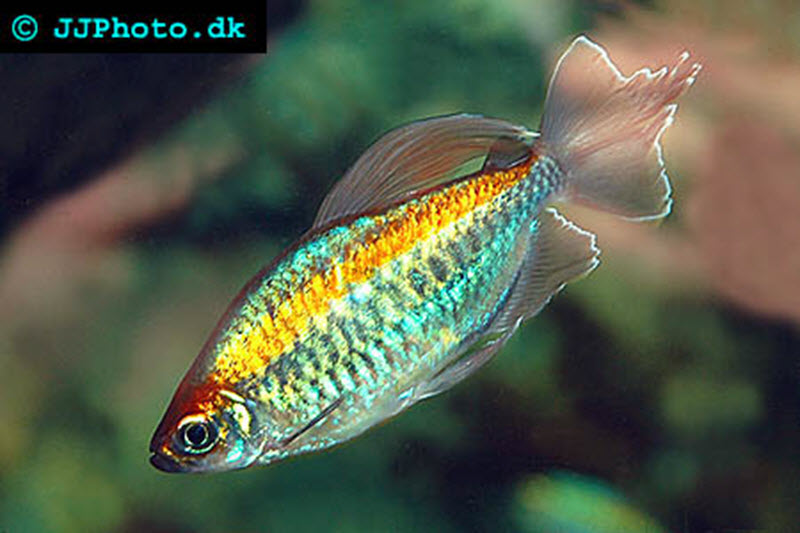Congo tetra – Phenacogrammus interruptus
The Congo tetra belongs to the genus Phenacogrammus within the family Characidae. The scientific name for this fish is Phenacogrammus interruptus. It can be a little bit jumpy when kept in aquariums, but you can make your Congo tetra feel safe and secure by decorating the aquarium wisely. Keep at least six Congo tetra together since this is a schooling fish. Do not keep Congo tetra with aggressive fish species that will bully them. The aquarium should be planted and provide many hiding places, but also contain open swimming areas. Most aquarists use a dark substrate in an aquarium where Congo tetra is kept.

Male Congo tetra. Copyright www.jjphoto.dk
A male Congo tetra can grow up to 3.5 inches, while a female usually stay around 2.5 inches. The aquarium should be at least 40 inches long. The body of a Congo tetra is elongated and this fish has big scales and eyes. When you look at a male Congo tetra you will notice that the middle rays of the caudal fin are very long. Males also have a distinguishing dorsal fin that goes all the way back to the caudal fin. A female Congo tetra is smaller than a male Congo tetra, and her fins are less elongated.
The colorations of a Congo tetra vary a lot between the individual fishes, and they are usually iridescent and very beautiful. On the sides of the fish you will find a light brown stripe, and under this stripe you can see a collection of other stripes. The color of these other stripes can vary from green to golden. The fins of the Congo tetra can anything from pale red to gray, while the base color of the Congo tetra is olive. The tail and anal fins all have white edges, and the anal fin have a dark blotch in the center. The belly is usually decorated with a purple or violet shade.
The Congo tetra originates from Central Africa, where it inhabits the Zaire river basin.

Female congo tetra
Congo tetra is not very difficult to breed in captivity, but the captive bred specimens offered in pet shops are unfortunately often of a lower quality compared to wild caught Congo tetra. Wild caught specimens usually have longer finnage and more pronounced colors, and are therefore more popular.
The Congo tetra will inhabit the top and middle regions of the aquarium. They will do best in slightly acidic water and you should ideally keep the pH in the 6-7.5 range. Soft water is recommended, but the Congo tetra can adapt to harder conditions. It needs warm water and the water temperature should be 73º F to 79º F (23 to 26°C). The Congo tetra is sensitive to poor water quality and frequent water changes are very important. Good water circulation in the aquarium is also necessary.
The Congo tetra is an insectivorous species, but you can usually train your Congo tetra to accept flake food and frozen food. A Congo tetra kept on nothing but flake food can however loose its coloration, and supplementing the diet with mosquito larvae, daphnia and brine shrimp is highly recommended.
If you want to breed Congo tetra you need a large breeding aquarium with bottom plants. The water should be acidic and very soft. A female Congo tetra will usually release around 300 eggs among the plants. Most Congo tetra females prefer to scatter their eggs during early morning, during the very first minutes of daylight. It will take around 6 days before the eggs hatch. Start feeding your Congo tetra fry rotifiers, brine shrimp or powdered flake food.